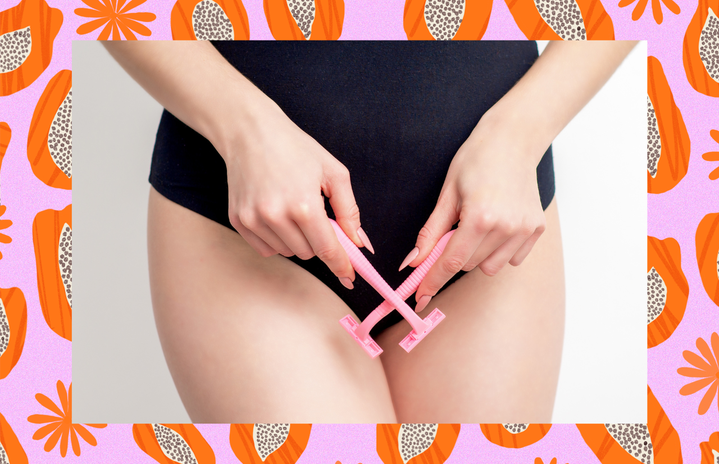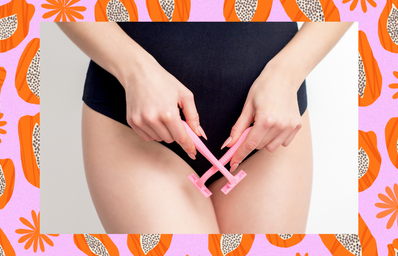

We’ve all been there: we’re invited to a pool day and throw on our cutest ‘kini…only to realize you forgot to groom down there. In a pinch, we grab a razor and some handsoap, lather it up, and quickly shave our bikini line before throwing on some cutoffs and running out the door. What follows (besides a lovely pool day and some cocktails) is a world of discomfort. Razor burn. Ingrown. Inflammation. And lots, and lots, of itching.
Maybe this oddly specific instance happened to me last week, but the fact is that shaving your pubic area is uncomfortable. But, surprisingly, it doesn’t have to be. If done correctly, pubic hair removal (I like to call it, ladyscaping) can actually be done with little to no discomfort. Yup, you heard that right.
Her Campus spoke to Dr. Marie V. Hayag, a board-certified dermatologist in New York City and Palm Beach, to learn more about removing pubic hair safely and easily. And trust us, you’re going to want to hear this.
Do I Have To Get Rid Of Hair down There?
No. You don’t have to if you do not want to. Body hair is natural, body hair is beautiful, and body hair should never be removed to make somebody else more comfortable with your body. However, for some people, removing body hair can make them feel more comfortable in their own skin, and provide an extra boost of confidence at the pool, beach, or bedroom. Remember: body hair removal is a choice!
For those of us who do prefer a bit of ladyscaping, we know the pain of getting rid of unwanted hair all too well. Luckily, there are a ton of options out there to aid in bikini hair removal.
Is shaving Safe?
Perhaps the most popular way to ladyscape, shaving is accessible, easy, and can be done in the comfort of your own bathroom. However, this method can oftentimes result in bumps, irritation, and inflammation in your pubic area. And we all know that’s not fun.
“Stay away from using old and dull razor blades to ensure the smoothest shave possible and to prevent cuts, irritation, razor burn, ingrown hairs, folliculitis, etc,” Hayag tells Her Campus. “The results of shaving are not as long-lasting as other methods and hair can grow back within a few days which can cause even further irritation.”
If you decide to shave your down-there-hair, Dr. Hayag recommends following these steps to ensure a comfortable, and skin-safe, shaving experience:
- Sanitize your tools using an antiseptic
- Trim away excess hair
- Take a shower or bath to cleanse the area
- Exfoliate using glycolic acid or salicylic acid-containing products
- Use a shaving cream or gel
- When shaving, pull the skin in the area taut to avoid cuts
- Always seek professional advice beforehand
How About Laser hair removal?
Laser hair removalprofessional laser hair removal
“Although there are a handful of FDA-approved at-home laser devices that can be used at home, laser hair removal should always be done with medical consultation and a trained professional,” Hayag says. “Lasers use light and heat to damage hair follicles, so if done incorrectly laser hair removal can result in burns, blisters, rashes, infection, pigmentation, and scarring. However, when done at a professional medical office, laser hair removal is one of the safest and most effective ways of permanently removing pubic hair.”
What’s the deal with waxing?
As my preferred way to ladyscape, I’ve found that waxing is a great method to tame my down-there-hair. However, at-home waxing kits come along with risks, and it might be best to hit up an aesthetician if you want to try out waxing.
“Currently, there are a variety of professional waxing services available as well as at-home wax kits and wax strips that can easily be purchased online or in stores,” says Hayag. “Waxing pulls the hair out directly from its follicles so it lasts longer than shaving; however there are still risks associated with waxing such as irritation, burns, ingrown hairs, and infections. I recommend going to a professional for waxing rather than doing an at-home session by yourself.”
Can I Use Hair Removal Creams?
Finally, hair depilatory creams (or hair removal creams) are another popular method for at-home ladyscaping. And while this method is easy, painless, and accessible, it can also irritate the skin. For that reason, talk to a professional and test out the cream somewhere else first before applying it to your bikini area.
“Due to the sensitive nature of the skin in our pubic area, depilatory creams are not ideal to use for ladyscaping,” Hayag explains. “Harsh chemicals can irritate our skin and cause allergic reactions, but many depilatory creams also have different formulas and concentrations for different areas of the body.
The doctor’s shopping advice? “Look for a cream that is best suited for pubic hair removal, as other types may be too strong for the area. Try the cream on a small patch of skin somewhere else on your body first to make sure you do not get an allergic reaction.”
Is Ladyscaping At Home Dangerous?
Look, I know we’re not made of money. And when it comes to aesthetics, you gotta do what you gotta do. Not everyone can afford laser treatments, luxurious waxes, and weekly trips to the sugaring spa. For that reason, at-home pubic hair removal is extremely common. However, it’s important to know the risks of at-home bikini hair removal, beyond just the irritation.
“Our skin in the genitalia area is very sensitive thus incorrectly removing pubic hair can result in irritation, ingrown hairs, and even infection,” Hayag says. “The use of at-home methods of hair removal such as shaving or waxing strips have an increased risk of adverse effects.”
Even with at-home removal, it’s still wise to talk to a professional before attempting any kind of pubic hair removal. And, if you have the cash, consider finding an aesthetician near you to take care of that ladyscaping. Trust me, it’s a great investment.
“Go to a professional for the best results,” Hayag tells Her Campus. “At-home treatments may be more cost-effective but if done incorrectly can negatively impact your health in many different ways. Waxing, sugaring, lasering, electrolysis, and other methods of more permanent hair removal are always safer with a professional.”
So, what if i choose an at-home method?
While it’s not the preferred way to ladyscape, it’s not necessarily frowned upon to practice at-home hair removal. Just remember to use safe, clean tools, and talk to a professional before attempting at-home pubic hair removal. And don’t forget aftercare!
“Apply an aftershave product that is soothing and moisturizing to avoid inflammation and ingrown hairs,” Hayag recommends. “Ingredients to look for include salicylic acid, glycolic acid, aloe vera, and oatmeal.”
Pubic hair aftercare goes further than just applying products, however. “After hair removal, wear breathable cotton underwear and avoid tight clothing for a few days to avoid irritation if you start to notice ingrown hairs or bumps on your skin afterward, apply a warm compress and use a topical hydrocortisone to calm inflammation and topical antibiotic to counter infections,” Hayag says.
Pubic hair removal can be a pain. However, if done correctly, you may be able to free yourself from the irritation, ingrown hairs, and inflammation that make your days just a little bit harder. Always remember to be clean, safe, and unafraid to reach out to a professional for hair-removal help. I wish you a lifetime of zero irritation, bestie.
- bikini hair removal
- body hair
- dermatologist
- hair removal
- skincare





































